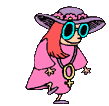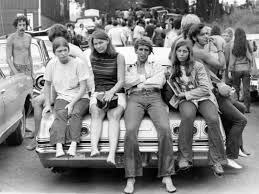
The Beatniks we know and love, with their requisite bongos, berets and turtlenecks, made their big screen debuts in Hollywood films like FUNNY FACE and BELL BOOK AND CANDLE in the late 1950s. They weren’t called beatniks yet, but they were black-clad, modern-dancing, angst-ridden Existentialists—a trés chicFrench export. These early beatnik stereotypes—goateed, bongo-beating espresso drinkers—were then portrayed as quaint and harmless, if somewhat silly.
But in American urban centers like New York and San Francisco, a youth culture that defined themselves as “beat”was forming. These were members of a generation whose spirits were beaten down by World War II and the new fear of atomic weaponry, and responded to the angst by rejecting the materialistic, straight-laced values of the 1950s mainstream. They listened to jazz. They experimented with drugs. They wrote stream-of-consciousness poetry. They danced to the beat of a different bongo, and went pretty much unnoticed. It was only after the publication of Jack Kerouac’s On the Roadin 1957 that the mainstream caught on. And before you could say “Daddy-O,” there was a beatnik backlash.
Hollywood took it upon itself to warn the rest of the nation about just what these crazy kids were up to, throwing in a goodly amount of 50s paranoia and sexploitation for good measure. In movies like HIGH SCHOOL CONFIDENTIAL and BEAT GIRL, beatniks are portrayed as a bunch of juvenile-delinquent drug pushers who expressed themselves with secret-code-like slang and weird poetry. There isn’t a beret to be found in either of these films; in beatsploitation flicks like THE PRIME TIME, THE REBEL SET, BUCKET OF BLOOD, and THE BLOODY BROOD, however, we get beatniks with all the trimmings: goatees galore, battalions of bongos, jazzed-up java and pathetic poetry. While TV’s “The Many Loves of Dobie Gillis” gave us a harmless Maynard G. Krebs, it was in these movies that the mainstream’s fear of these new bohemians really rears its square head. If they dig breaking the rules of conventional society, these films seem to ask, where do these cats draw the line? Beatniks give way to bad-nicks, be they homicidal psychopaths out for sadistic kicks or, less bleakly, vulnerable wannabe artists who become lackeys for hardened criminals.
The sexual experimentation of the beats, particularly that of the girls, is especially threatening to the impresarios of squaresville. While these films coyly eye the voluptuous curves of beat-chicks as they “express themselves” to the wild beat of the bongo in skin-tight black pants and sweaters, by the time the credits roll most of these gals end up dead or working in strip clubs.
Eventually, the beats went back to being thought of as a quaint, wacky subculture. In the 1980s, HAIRSPRAY gave us a pair of harmless pot-smoking, beatnik freakazoids; in a bizarre case of life imitating (non-)art, the 1990s saw a rise of neo-beatnik coffee houses and a revived poetry scene, seemingly inspired more by the beat-flicks than the beatniks.
Like, strictly dullsville, man. </end>
Bucket of Blood, The Bloody Brood, The Rebel Set, and The Prime Time are available from Something Weird Video. For a complete catalog send $3.00 to “S.W.V. Catalog”, Dept. FUN, P.O. Box 33664, Seattle WA 98133. Please state with signature that you are 18 or older.
Illustrations by jorja rucker
Beat-FlickPlot SummaryIdentifying Beatnik TraitsBeatnik HangoutMeaningful Beatnik Philosophical StatementsAtypical Beatnick activitySubstance(s) abused
Funny Face
(1956)
In this Hollywood musical, Greenwich Village bookstore clerk Jo Stockton (Audrey Hepburn) is discovered by the editor of a fashion magazine and flown off to Paris with photographer Dick Avery (Fred Astaire). Although she disapproves of the world of fashion (“it’s chi-chi and an unrealistic approach to self-impressions as well as economics”), Jo takes the trip so that she can hang out with Parisian intellectuals and meet the father of “Empathicalism.” of which she is a loyal disciple. The philosopher turns out to be a cad (“he’s more man than philosopher”), and Jo ends up falling in love with Dick.









An underground Parisian cafe with live jazz.
“All that is delicious is not nutritious.”
“I feel a hostile vibration.”
Spontaneous song & dance numbers; headstands; tap dancing.
Wine; modern dance; Gershwin tunes.; overuse of the word “pizzazz.”
Bell, Book & Candle
(1958)
Gillian Halroyd (Kim Novak) is an African art dealer and practicing witch who falls for stodgy publisher Sheperd Henderson (Jimmy Stewart). With some help from her witch associates—her aunt Queeny and brother Nicki (Jack Lemmon)—she sets out to win his heart.
While not a movie about beatniks per se, the movie draws some interesting parallels between witches and beatniks: when not casting spells, the three hang out with the witch in-crowd at an underground jazz bar where Nicki plays bongos, and Gillian shows a penchant for wearing black and a dislike for shoes. And, like most witches, they live outside the rules of normal society.









The Zodiac: an underground, brick-walled bar with live jazz for the occult set.
“Don’t you ever wish that you weren’t what we are? That you could just spend Christmas Eve in a little church somewhere, listening to carols, instead of bongo drums?”
“It might be pleasant to be humdrum once in a while.”
“That’s what happens to people like us. We forfeit everything and we end up in a little world of separateness from everyone.”
Witchcraft.
Herbs, potions, spells.
High School Confidential
(1958)
Although the original trailer hypes this movie as the story of “The Beat Generation,” it contains only one conspicuous beatnik scene. Tony Baker (Russ Tamblyn) is the new bad kid in town, a weedhead who wants to be the top “reefers” dealer. Standing in the way of his ambitions is J.I. (John Drew Barrymore) the president of the “Wheelers and Dealers” gang. This classic J.D. extravaganza features an outstanding cameo performance by Phillipa Fallan as the ultra-hip beatnik poetess who performs at the coffee shop, accompanied by Jackie Coogan on piano.



Brick-walled coffee club with live jazz.
“Tomorrow is a drag, pops. The future is a flake.”
“Sleep, man, and you might wake up diggin’ the whole human race.”
“That’s the way the bongo bingos.”
Pool parties; drag racing; drug-dealing; Narc-ing.
Cigarillos; weed; reefers; Mary Jane; “H”; coke; goofballs.
The Bloody Brood
(1959)
 A perfect square.
A perfect square.
 He’s tuned in.
He’s tuned in.
 Get with it cats.
Get with it cats.
Peter Falk plays Nico, a drug dealing gangster who hangs out with beatniks. Nico has a delivery boy killed as an existentialist party trick but the joke’s on him when the delivery boy’s brother traps him with his own secret weapon—a deadly poem.











The Digs: a brick-walled underground jazz bar.
“Fish—all mouth and eyes. They don’t think, they don’t feel, they just go round and round like squares. ”
Murder by hamburger.
Wine; weed; heroin; ground glass.
Bucket of Blood
(1959)
 Sour cream of circumstance.
Sour cream of circumstance.
 Crazy, what is it called?
Crazy, what is it called?
In this Roger Corman horror/comedy, Walter (Dick Miller) is the talentless coffee-shop waiter with ambitions to be an artist—they get all the girls! He quickly discovers an easy way to create life-like sculptures: he starts with something dead! His first piece, “Dead Cat,” gains him the acceptance of the beatnik in-crowd, and he follows it up with “Murdered Man” and “Female Nude.”







The Yellow Door: An underground, brick-walled coffee house with live poetry.
“What is not creation is graham crackers; let it all crumble to feed the creator.”
Killing things; covering dead things with clay and calling them sculpture.
Coffee, money, heroin, clay.
The Rebel Set
(1959)
 Far-out dancing girl
Far-out dancing girl
 When in Rome, do the Romans.
When in Rome, do the Romans.
Mr. Tucker (Edward Platt), a diabolical coffee bar owner, invites three ambitious but unsuccessful beatniks—an actor, a writer, and the jailbird son of an actress—to help him pull off a million-dollar armored car hold-up. The plan involves a train to New York from Los Angeles with a three hour lay-over in Chicago—just long enough to pull off the job. The robbery comes off without a hitch, but it’s on the train trip back to New York that the fun really begins as Mr. T, now cleanly shaven and posing as a minister, sets out to eliminate his beatnik partners-in-crime.













Mr. T’s Cafe: An underground, brick-walled coffee bar with live jazz and poetry.
“A rose by any other name would still have thorns.”
“When in Rome, do the Romans.”
“I am bugged beyond recall.”
“I don’t dig you. All this chopper music and no tune.”
Armed robbery; murder; jumping from trains.
Bullets.
Beat Girl
(1960)
 Dig that crazy saxophone.
Dig that crazy saxophone.
 Strictly for kicks!
Strictly for kicks!
In this British import, teenage bad girl Jenny (Noelle Adams) doesn’t like her new step-mother, so she digs for dirt on her past at the local strip joint. When her folks are asleep, art student Jenny sneaks out of the house to hang out with her “beatnik” pals at the local coffee shop where they talk about alienation and jazz while playing rockabilly.





The Off Beat: a coffee bar with an underground jazz club.
“We don’t wear dresses very often. We’re different.”
“Next week—voom—up goes the world in smoke. So now, while it’s now, we’ll live it up. Do everyting, feel everything—strictly for kicks.”
Stripping; drag racing; being British.
None: “Drinks are for squares!”
The Prime Time
(1960)
Jean (Jo Ann LeCompte) is a teenage hot tamale who’s having an affair with a local investigator. When Jean is stood up by her beau, she retaliates by posing nude for “the beard” (Roy Gronwold) a local beatnik artist. All goes well until she taunts him about his masculinity (she calls him a “shrimp”), thereby forcing him to kill her.





The Golden Goose Lounge: An underground bar with live rockabilly.
“Like I’m there…I’m on the A train.”
“You wanna play quiz games, get on TV.”
“The Beard needs money!”
Murder; ability to paint the backside view of a person while they are posing from the front.
Alcohol; cigarillos; poison; gas; matches
Heart Beat
(1980)
Based on the book by Carolyn Cassady, this movie tells the tale of some real beatniks: Carolyn (Sissy Spacek), Jack Keroac (John Heard) and Neal Cassady (Nick Nolte.) Neal is the irresponsible bad boy and Jack the sincere, struggling novelist. They both fall in love with the same woman: a proper, upper-class art student. Although it is Neal who marries her, he makes for a lousy husband, and Jack comes to live with them as her lover. The three cool cats have a fabulous, anti-establishment time living in the ‘burbs until Jack’s book is published, bringing him sudden fame, and the birth of the media hype surrounding “beatniks.”








Bud’s Bop Shop: an underground brick-walled jazz club; an underground brick-walled poetry club capitalizing on the “beatnik” craze; The Five Spot: another underground brick-walled jazz club.
“All I need to write is a pencil!”
“You wanna know about civilization? Ask any bum on the Bowery after he’s had twelve shots of Sterno. The puke-encrusted scabs on his face are a more eloquent poem than Eliot ever wrote! ”
“This entire generation is a constipated pack of cowering illiterates.”
“Everybody wants to be hip. Even old Jack wishes he was a spade.”
Suburban living; having kids; wife-swapping.
Pot; alcohol; “Bennies”; friendships.
Hairspray
(1988)
This John Waters flick takes place in Baltimore in 1962. Tracy Turnblad (Ricki Lake) becomes queen of the local dance show, “The Corny Collins Show,” and takes up the cause of racial integration. In an unforgettable scene, Tracy and her friends seek shelter at the apartment of two wacky beatniks (Pia Zadore and Rick Ocasek) while trying to evade “the fuzz.”







Run-down brick-walled pad.
“When I’m high I am Odetta. Let’s get naked and smoke!”
Hair consciousness: hair-ironing.
loco-weed; irons (“I get high, listen to Odetta, and iron my hair!”).

Beat-FlickPlot SummaryIdentifying Beatnik TraitsBeatnik HangoutMeaningful Beatnik Philosophical StatementsAtypical Beatnick activitySubstance(s) abused
0.000000
0.000000


























